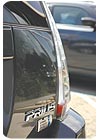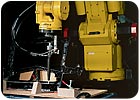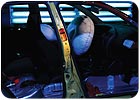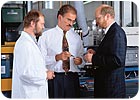Driving Advances in Adhesives & Sealants
The trend toward increased efficiency, improved safety and alternative fuels in next-generation vehicles is leading to innovations in adhesive and sealant technologies.

What will be the most popular automotive technology in 2012? Will E85 fuel catch on with U.S. consumers? Will hybrid vehicles trump modern SUVs? Do fuel cell platforms really have a chance at replacing the internal combustion engine? Competition in today’s automotive industry is fierce, and the manufacturers that can pinpoint and pursue the next biggest trend undoubtedly will have a competitive edge in the market. Unfortunately, it’s not quite as simple as it sounds. Besides the obvious lack of a crystal ball, new automotive technologies - from E85-compatible vehicles to gas-electric hybrids, fuel cells and beyond - require new joining and sealing materials, and often one can’t move forward without the other.
“It’s kind of a chicken-and-egg situation, because the automotive manufacturers expect the technologies to be ready and available commercially when we need them,” one automotive research engineer said. “But on the other side of that, we can’t promise a market for those adhesives and sealants within any specific timeframe.”
Fortunately, close partnerships between automotive manufacturers and adhesive and sealant suppliers are driving advances on both sides. As automotive engineers pursue the basic tenets of fuel efficiency, safety and environmental sustainability through various technologies, corresponding innovations in adhesives and sealants are helping them achieve their goals.
These trends are leading to significant changes in the way cars are manufactured. Plastics, aluminum, magnesium and various composites, as well as advanced steels such as dual-phase and high-strength steel, increasingly are replacing thicker, heavier steel in body designs. These materials often are used in combination with each other and with other materials to achieve a lighter weight, more fuel-efficient frame, but joining these materials poses a significant challenge. Welding, the conventional joining technique used with steel, is more difficult and sometimes impossible when joining dissimilar materials, particularly with advanced materials such as magnesium and high-strength steel. Likewise, mechanical fasteners create high-stress-point loads that can compromise vehicle safety. As a result, many manufacturers are beginning to turn to advanced structural adhesives to supplement or replace welds and mechanical fasteners.
One example is in front-end carrier systems, in which a metal reinforcement traditionally is attached to a plastic substrate using mechanical techniques such as rivets or heat stakes, or through over-molding. New low-energy substrate adhesive technologies can allow materials with low surface energies, such as polypropylene, to be bonded to dissimilar substrates without the use of a pretreatment. Using adhesives in this application, therefore, can reduce the cost and complexity of the bonding process, while improving the quality and consistency of the assembly.
“You would think that the welded metal part would be stiffer than a bonded plastic part, but that isn’t the case. Front-end carriers using the adhesive technologies have exhibited a 100% improvement in the part stiffness,” says Steve Henderson, vice president of Body Structure, Energy Management and Acoustics for Dow Automotive.
According to Rajat Agarwal, Henkel senior chemist and technical director of Adhesives and Sealants, using structural adhesives to supplement and/or replace welds throughout a vehicle can increase the overall stiffness by as much as 20%, depending on the vehicle.
“Adhesives allow automotive engineers to down-gauge steel in certain areas without loss of durability,” he says, “because they spread the load over a larger area rather than just a small spot weld. That’s both a weight and cost benefit for auto manufacturers.”
“At the moment, there’s a tendency to use just one adhesive, maybe a high-value structural adhesive, in all applications,” says Chris Liddiard, director of Strategic Solutions for Henkel. “But that is now changing significantly with some of the new adhesives and new ways of using adhesives. In the future, we will probably see a more tailored use of adhesives, so that a stiffness adhesive is used where stiffness is needed, and a crash-resistant adhesive is used where it’s needed.”
“The changing and increasing requirements of safety standards, along with the wide range of materials being used to form vehicle body structures, are paving the way for many types of innovations to be made in creating the next generations of structural adhesives and composite bonding concepts,” adds Dr. Matthew Harthcock, director of Research and Development at L&L Products.
These trends will help drive the use of adhesives overall. “At least for the short-term, we expect a significant increase in the amount of structural adhesives used in car body construction,” Liddiard says.

New sealants are also being required to withstand new generations of engine oils.
“All engine oils - particularly the synthetics - are seeing new chemistry packages with anti-corrosive additives designed to prolong the life of the oil,” Agarwal says. “These additives tend to be quite aggressive on sealants. So we’re having to develop new technologies to keep up with these ever-changing oils in the marketplace.”
One other area that is still under development is that of fuel cells, where an entirely new class of gasketing products is required to seal fuel-cell assemblies against the ethanol, methanol and other low-molecular-weight alcohols produced in these systems. “For these applications, we are tailoring chemistries - for example, some fluoropolymers, or combinations of acrylics and fluoropolymers - to come up with viable solutions,” Agarwal says.

“We have to continually anticipate where the market is going,” Agarwal says. “Some trends are clear. For example, there will be an increasing use of magnesium, there will be regulations to reduce emissions, engines are going to get smaller and temperatures are going to go up, and weight is going to be a more critical factor in the body structure as fuel gets more expensive.”
As for the others? “It’s a matter of continuing to work closely with the OEMs to try to pinpoint areas of weakness, and then developing new technologies to meet those needs,” Henderson says. “There are a lot of challenges, but also a lot of opportunities.”
Christine L. Grahl is a freelance technical writer based in West Bloomfield, MI. She can be reached at grahlk@sbcglobal.net.
The Adhesive and Sealant Council, Inc. (ASC) is a North American trade association dedicated to representing the adhesive and sealant industry. For more information, visit www.ascouncil.org.

“Engineers know how to design with steel, but there is a learning curve associated with how to design with steel and polymers or adhesives. As a result, my role as a chemist has had to expand,” explains Rajat Agarwal, senior chemist and technical director of Adhesives and Sealants for Henkel. “I’m not just developing adhesives but am also educating and forming partnerships to show engineers how to use those adhesives, both the application side, and on the engineering side with how to design structures combining these materials,” he said.
Today’s chemists must essentially become engineers, combining chemistry with simulation techniques such as finite-element analysis to convince engineers of the utility of a material and explain to engineers how to use the material.
“In the past, there was a definite focus on chemistry; now there’s more of a focus on engineering. This trend likely will continue in the future,” Agarwal says.

At the 2006 Polk Automotive Loyalty Awards, presented in January 2007 by R.L. Polk & Co., the Toyota Prius won the Midsize Car segment, becoming the first hybrid vehicle to be so honored. Photo: drumcpherson.com
What will be the most popular automotive technology in 2012? Will E85 fuel catch on with U.S. consumers? Will hybrid vehicles trump modern SUVs? Do fuel cell platforms really have a chance at replacing the internal combustion engine? Competition in today’s automotive industry is fierce, and the manufacturers that can pinpoint and pursue the next biggest trend undoubtedly will have a competitive edge in the market. Unfortunately, it’s not quite as simple as it sounds. Besides the obvious lack of a crystal ball, new automotive technologies - from E85-compatible vehicles to gas-electric hybrids, fuel cells and beyond - require new joining and sealing materials, and often one can’t move forward without the other.
“It’s kind of a chicken-and-egg situation, because the automotive manufacturers expect the technologies to be ready and available commercially when we need them,” one automotive research engineer said. “But on the other side of that, we can’t promise a market for those adhesives and sealants within any specific timeframe.”
Fortunately, close partnerships between automotive manufacturers and adhesive and sealant suppliers are driving advances on both sides. As automotive engineers pursue the basic tenets of fuel efficiency, safety and environmental sustainability through various technologies, corresponding innovations in adhesives and sealants are helping them achieve their goals.
Enhanced Fuel Efficiency and Safety
Record-high gas prices are forcing an increasing number of people to consider trading their gas guzzlers for more fuel-efficient cars. In a recent Associated Press-Ipsos poll, 47% of respondents indicated that they have thought seriously about purchasing a more fuel-efficient vehicle, compared to 39% a year ago.1 Power Information Network, a division of J.D. Power and Associates, noted that the market share for compact vehicles increased from 21.5% of total retail sales in April 2000 to 37.5% in April 2007.2 Likewise, gas-electric hybrids are becoming increasingly popular among consumers. In the 2006 Polk Automotive Loyalty Awards, presented in January 2007 by R.L. Polk & Co., the Toyota Prius won the Midsize Car segment, becoming the first hybrid vehicle to be honored.These trends are leading to significant changes in the way cars are manufactured. Plastics, aluminum, magnesium and various composites, as well as advanced steels such as dual-phase and high-strength steel, increasingly are replacing thicker, heavier steel in body designs. These materials often are used in combination with each other and with other materials to achieve a lighter weight, more fuel-efficient frame, but joining these materials poses a significant challenge. Welding, the conventional joining technique used with steel, is more difficult and sometimes impossible when joining dissimilar materials, particularly with advanced materials such as magnesium and high-strength steel. Likewise, mechanical fasteners create high-stress-point loads that can compromise vehicle safety. As a result, many manufacturers are beginning to turn to advanced structural adhesives to supplement or replace welds and mechanical fasteners.
One example is in front-end carrier systems, in which a metal reinforcement traditionally is attached to a plastic substrate using mechanical techniques such as rivets or heat stakes, or through over-molding. New low-energy substrate adhesive technologies can allow materials with low surface energies, such as polypropylene, to be bonded to dissimilar substrates without the use of a pretreatment. Using adhesives in this application, therefore, can reduce the cost and complexity of the bonding process, while improving the quality and consistency of the assembly.
“You would think that the welded metal part would be stiffer than a bonded plastic part, but that isn’t the case. Front-end carriers using the adhesive technologies have exhibited a 100% improvement in the part stiffness,” says Steve Henderson, vice president of Body Structure, Energy Management and Acoustics for Dow Automotive.
According to Rajat Agarwal, Henkel senior chemist and technical director of Adhesives and Sealants, using structural adhesives to supplement and/or replace welds throughout a vehicle can increase the overall stiffness by as much as 20%, depending on the vehicle.
“Adhesives allow automotive engineers to down-gauge steel in certain areas without loss of durability,” he says, “because they spread the load over a larger area rather than just a small spot weld. That’s both a weight and cost benefit for auto manufacturers.”
A Safer Crash
Along with the increased stiffness provided by structural adhesives in lightweight automotive body designs have come developments to improve safety. While a stiffer frame undoubtedly enhances a vehicle’s durability, a key advance has been the ability to develop one class of adhesives for stiffening and a separate class of adhesives that improve the crash-resistance of the structure - both by increasing the durability of the bonded joints and increasing the vehicle’s energy absorption in crashes.“At the moment, there’s a tendency to use just one adhesive, maybe a high-value structural adhesive, in all applications,” says Chris Liddiard, director of Strategic Solutions for Henkel. “But that is now changing significantly with some of the new adhesives and new ways of using adhesives. In the future, we will probably see a more tailored use of adhesives, so that a stiffness adhesive is used where stiffness is needed, and a crash-resistant adhesive is used where it’s needed.”
“The changing and increasing requirements of safety standards, along with the wide range of materials being used to form vehicle body structures, are paving the way for many types of innovations to be made in creating the next generations of structural adhesives and composite bonding concepts,” adds Dr. Matthew Harthcock, director of Research and Development at L&L Products.
These trends will help drive the use of adhesives overall. “At least for the short-term, we expect a significant increase in the amount of structural adhesives used in car body construction,” Liddiard says.

Many automotive manufacturers are beginning to turn to advanced structural adhesives to supplement or replace welds and mechanical fasteners. Photo courtesy of Dow Automotive.
Sealant Solutions
While advanced adhesives are playing a crucial role in making next-generation cars and trucks safer and more fuel efficient, sealants are also evolving to help the automotive industry take advantage of alternative fuels. For example, silicon gaskets used in automotive engines are being replaced by higher-end polyacrylates, which are less permeable to fuels such as E85. For hybrid electric engines, which incorporate electric coils to capture and reuse some of the energy normally lost through friction during braking, new sealants are being developed that can operate under a range of temperatures and protect the coils from humidity, dust, dirt, and other elements, thereby preventing corrosion.New sealants are also being required to withstand new generations of engine oils.
“All engine oils - particularly the synthetics - are seeing new chemistry packages with anti-corrosive additives designed to prolong the life of the oil,” Agarwal says. “These additives tend to be quite aggressive on sealants. So we’re having to develop new technologies to keep up with these ever-changing oils in the marketplace.”
One other area that is still under development is that of fuel cells, where an entirely new class of gasketing products is required to seal fuel-cell assemblies against the ethanol, methanol and other low-molecular-weight alcohols produced in these systems. “For these applications, we are tailoring chemistries - for example, some fluoropolymers, or combinations of acrylics and fluoropolymers - to come up with viable solutions,” Agarwal says.

Advanced adhesives can improve the crash-resistance and increase the energy absorption of today's vehicles. Photo courtesy of Henkel.
Continued Advances
So which will come first for the cars of the future - the advanced automotive technologies, or the adhesives and sealants that make these technologies feasible?“We have to continually anticipate where the market is going,” Agarwal says. “Some trends are clear. For example, there will be an increasing use of magnesium, there will be regulations to reduce emissions, engines are going to get smaller and temperatures are going to go up, and weight is going to be a more critical factor in the body structure as fuel gets more expensive.”
As for the others? “It’s a matter of continuing to work closely with the OEMs to try to pinpoint areas of weakness, and then developing new technologies to meet those needs,” Henderson says. “There are a lot of challenges, but also a lot of opportunities.”
Christine L. Grahl is a freelance technical writer based in West Bloomfield, MI. She can be reached at grahlk@sbcglobal.net.
The Adhesive and Sealant Council, Inc. (ASC) is a North American trade association dedicated to representing the adhesive and sealant industry. For more information, visit www.ascouncil.org.

Chemists and engineers increasingly must collaborate to develop adhesives and sealants that perform under extreme conditions. Photo courtesy of Henkel.
SIDEBAR: Chemist Or Engineer?
At one time, a doctorate degree in chemistry used to pretty much guarantee someone a position in a university or corporate laboratory, formulating the next cutting-edge material behind a microscope and various high-tech analytical instruments. Today, that role is changing, as companies and individuals struggle with how to implement some of the newest technology advances.“Engineers know how to design with steel, but there is a learning curve associated with how to design with steel and polymers or adhesives. As a result, my role as a chemist has had to expand,” explains Rajat Agarwal, senior chemist and technical director of Adhesives and Sealants for Henkel. “I’m not just developing adhesives but am also educating and forming partnerships to show engineers how to use those adhesives, both the application side, and on the engineering side with how to design structures combining these materials,” he said.
Today’s chemists must essentially become engineers, combining chemistry with simulation techniques such as finite-element analysis to convince engineers of the utility of a material and explain to engineers how to use the material.
“In the past, there was a definite focus on chemistry; now there’s more of a focus on engineering. This trend likely will continue in the future,” Agarwal says.
Looking for a reprint of this article?
From high-res PDFs to custom plaques, order your copy today!






